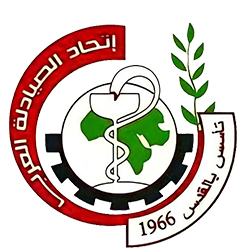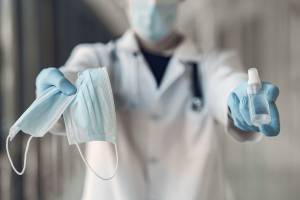You Will Learn
-
infection surveillance
Hand hygiene, sterilization, and disinfection
Correct use of antibiotics
How to deal with catheters and installation devices for patients and
the ventilator
Occupational health and transmission methods
The importance of using gloves
Infection control in medical laboratories and correct injection
methods
1. Identify the six components of the chain of infection.
2. Identification of risk factors for transmission.
3. Learn the different types of causative agents (pathogen) and how
to develop strategies to overcome the agent.4. Recognize the different types of infection centers and how to
manage them to break the chain of infection
5. Learn about the exit and entry gate in each of the centers, the
sensitive new host and how to use barriers and preventive measures
against the exit and entry gate.
6. Learn the different modes of transportation and how to develop
barriers to overcome these modes of transportation.7. Identification of the potentially infected host and how to develop
strategies to rescue the susceptible host.
8. Learn common public health infection prevention and control
terms, definitions, and rates, for example, colonies, contamination,
infection, incubation period, infective period, disease carrier, and
rates such as death rate, baseline reproductive rate, and next attack
rate.
Standard Precautions Components of a hand hygiene program and
monitoring and audit tools:
1. What are the standard precautions?
2. What are the items of standard precautions
3. Hand hygiene: components of a hand hygiene program
4. Hand hygiene resources
5. Learn 7 steps to practice hand hygiene: Explanation and video
demonstration6. Determine the necessary posters be communicated to
employees, customers, and visitors regarding hand hygiene.
7. Component of the WHO Hand Hygiene Monitoring Model
8. How to develop and implement a hand hygiene audit program
with the goal of achieving a 100% compliance rate.
9. Sharing the results of previously published studies on the rate of
hand hygiene compliance among healthcare professionals.
Standard Precautions (Part Two): Proper use of PPE, types, on and
off process, and when to use it in different scenarios
1. Identify the different types of safe disposable syringes
recommended by the World Health Organization
2. Learn the safe injection practice recommended by the World
Health Organization
3. Learn about the Sharp component.
4. Learn how to prevent acute injuries
5. Learn how to treat acute injuries
6. Learn how to analyze the root causes of acute injuries and learn
how to prevent their recurrence.Standard Precautions (Part IV): Cleaning of Medical Equipment
and Environmental Health
1. Learn the difference between cleaning and disinfection and the
principles of both2. Learn about the precautions healthcare workers should take
while cleaning medical equipment
3. Learn how to find Information for Use (IFU) for medical
equipment intended for cleaning
4. Determine the different environmental areas to be cleaned in a
health facility
5. Identify surfaces most likely to become contaminated with
pathogens
Specific areas and resource cleaning/disinfection, accountability,
redundancy, and audit
7. Identify different types of leaks in a healthcare facility
8. Determine the resources needed to manage leaks
9. Learn how to manage different types of leaks and who is
responsible by service area
10. Know the requirements of the waste treatment roomStandard Precautions (Parts Five and Six): Managing Bedding,
Covering, and Infectious Respiratory Disease Prevention Program:
1.Learn the principles of managing covers and upholstery from the
point of collection, handling, transportation, storage, and use.
2. Know the common area of non-compliance to properly manage
upholstery and linen.
3. Learn how to develop a program to prevent infectious respiratory
diseases.4. Know the difference between a droplet infection and an airborne
infection
5. Identification of high-risk healthcare professional groups for
infectious respiratory infection
6. Learn the difference between medical masks and respirators and
their pros and cons to avoiding a respiratory infection
7. Get to know the right person to use respirators by applying the
OSHA Ventilator Medical Assessment Questionnaire
8. Learn cough etiquette
9. Principles of social distance
Description
Infection control has become the most important prevention shield
to protect patients and workers inside health facilities, so we offer you a special opportunity with the accredited “Specialized Infection
Control” diploma, as it qualifies you to become a certified infection control specialist and a member of the infection control team in the
largest Arab and international hospitals
It is known that the most prevalent places for infection are hospitals and health facilities, so every person working in the medical field must take this course because it makes him a distinguished specialist and has a certified infection control certificate and makes him rise in his work and become among the largest infection control team in
hospitals globally.
The person will know a lot of information about the course, the most important of which are:
First, what is the meaning of the word infection?
He will know all the details about the infection.
How to maintain hands and how to sterilize and disinfect them.
The correct time to use antibiotics.
He will also learn how to insert a catheter and how to use it on patients.
He will learn the correct method of injection in medical laboratories to combat infection.
Importance and necessity of using gloves
The essential importance of everything about infection. For these reasons, people working in the medical field must rush to take this
infection control course, because it is one of the most important courses that a person takes, whether he works in the medical field or others.
Its control (IPC) is a scientific approach and a practical solution designed to prevent harm from infection to patients and health workers.
It is grounded in infectious disease, epidemiology, social sciences, and health system strengthening.
IPC is unique in-patient safety and quality UHC because it is relevant to health workers and patients in all aspects of health care.
In this training module, you will have a clear practical insight into infection prevention and control as per the requirements of various
local and international accreditation standards in the GCC and other Middle East countries. You will learn how to do things and understand common mistakes some practitioners make to avoid.
Learn from a certified expert how to meet the standards and create a guide to compliance with IPC standards.
Accreditations


Certified Professional in Infection Control (CPIC) Courses

Smart Management Consultancy
Infection Prevention and Control Principles
Infection prevention and control (IPC) is a scientific approach and practical solution designed to prevent harm caused by infection to patients and health workers. It is grounded in infectious diseases, epidemiology, soc...
Certified Professional in Infection Control (CPIC)
Some lectures will remain locked until you watch the previous ones.48:30
54:46
43:22
45:39
59:36
37:11
58:37
54:20
01:10:53
48:59
27:37



